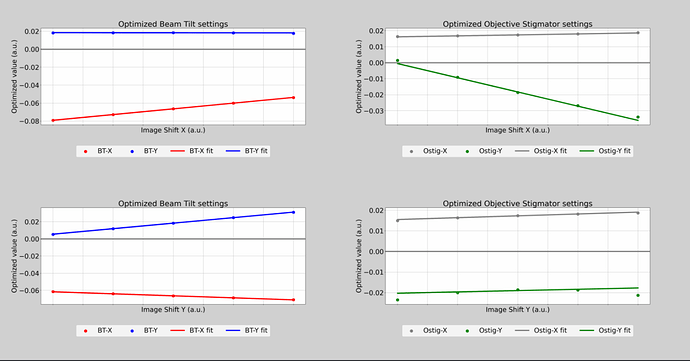As far as I know, there is no easy way for you to estimate global resdiual beam tilt without having a particle stack and 3D reconstruction, and doing CTF refinement (either local or global). With AFIS grouping being a function introduced recently, it should be possible to estimate the global residual beam tilt using AFIS cluster info since the calibration running in the background is static and linear. A feature letting one be able to estimate residual beam tilt on a per-micrograph basis rather than with a refined map and particle stack could also give people an early warning sign that there are problems with the data without having to go through extensive processing first.
Hi @michaeladams,
Thanks for bringing this up! It would be great if you can provide more details about how you think such a feature would be helpful - would the primary purpose be to understand misalignment in the microscope? Additionally, could you provide more details about how residual beam tilt could be estimated without a 3D reference and particle locations?
All the best,
Kye
Hello Kye, thanks for the reply.
Apologies in advance if this is a bit incoherent, but this would indeed serve to quickly inform the user of any possible alignment issues. The primary use case would be with a dataset on an UltrAuFoil grid since gold sample carriers are becoming more and more popular grid types and you can’t run coma correction on them due to their lack of a carbon foil. When switching from a carbon grid where the alignments are done to the grid of interest, the passage of time and frequent changes in optical parameters may have a detrimental impact on the data. Because the user is basically blind to optical aberrations at this point, I am suggesting this change.
Below is a screenshot of what the output of an AFIS calibration looks like. Please note that this calibration is done by introducing a beam/image shift across positive and negative X- and Y- axes at various distances away from the optical axis. At each step across thix X/Y matrix, beam tilt (coma) and objective stigmator (image astigmatism) are measured and corrected. At the end of the routine, each of the data points is plotted and a linear correction for tilt and stigmators for X- and Y- axes is created. AFIS routines such as the one used by EPU then uses this calibration to correct for aberrations.
Due to the linear and static nature of this calibration, there is some inherent error that remains present with each dataset that is collected, which should increase in magnitude as you move farther off the optical axis. This effect would manifest itself in astigmatism and coma in the image. Because we can import the beam/image shift values and cluster micrographs into optics groups, it could thus be possible to measure the aberrations across the AFIS cluster on a per-migrograph or per optics group basis to generate a Zemlin-like tableau, to identify any residual beam tilt in the images where no Beam/Image shift was imposed. If there is some obvious thing I am missing here that would make this not feasible, please let me know and I would be happy to discuss.
Hi @michaeladams,
Thanks for providing us with this info, we have noted the request and will be in touch if we have any further questions.
Best,
Kye
